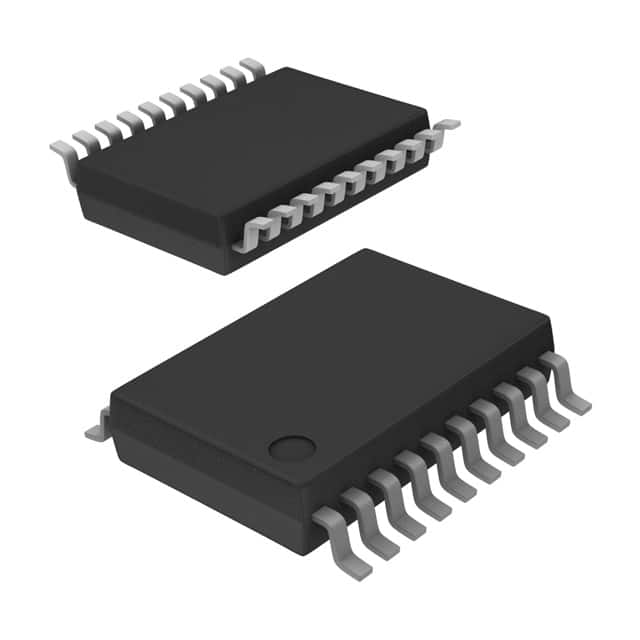Viz Specifikace pro podrobnosti o produktu.

SN74LVC244ADBRE4
Product Overview
- Category: Integrated Circuit (IC)
- Use: Buffer/Line Driver
- Characteristics:
- Low-voltage CMOS technology
- High-speed operation
- Wide operating voltage range
- Schmitt-trigger inputs for noise immunity
- Package: SOIC (Small Outline Integrated Circuit)
- Essence: Logic Level Shifter
- Packaging/Quantity: Tape and Reel, 2500 units per reel
Specifications
The SN74LVC244ADBRE4 is an integrated circuit belonging to the buffer/line driver category. It utilizes low-voltage CMOS technology, allowing for high-speed operation while maintaining a wide operating voltage range. The device features Schmitt-trigger inputs, providing excellent noise immunity.
Detailed Pin Configuration
The SN74LVC244ADBRE4 package consists of 20 pins arranged in a Small Outline Integrated Circuit (SOIC) format. The pin configuration is as follows:
- A1
- Y1
- A2
- Y2
- GND
- Y3
- A3
- Y4
- A4
- Y5
- GND
- Y6
- A5
- Y7
- A6
- Y8
- VCC
- OE#
- GND
- OE#
Functional Features
The SN74LVC244ADBRE4 offers the following functional features:
- Logic level shifting: The IC can convert signals between different logic levels, making it suitable for interfacing between devices operating at different voltage levels.
- Buffering: It provides buffering capabilities, ensuring signal integrity and preventing signal degradation during transmission.
- Noise immunity: The Schmitt-trigger inputs enhance noise immunity by reducing the impact of input signal noise.
Advantages and Disadvantages
Advantages of the SN74LVC244ADBRE4 include:
- High-speed operation: The IC operates at a high speed, enabling efficient data transmission.
- Wide operating voltage range: It can accommodate a wide range of input and output voltage levels, enhancing compatibility with various devices.
- Noise immunity: The Schmitt-trigger inputs minimize the impact of noise on signal integrity.
Disadvantages of the SN74LVC244ADBRE4 include:
- Limited current drive capability: The IC has a relatively low current drive capacity, which may restrict its use in applications requiring higher current levels.
- Power consumption: While designed for low-voltage operation, the IC still consumes power during operation, which should be considered in battery-powered applications.
Working Principles
The SN74LVC244ADBRE4 operates based on CMOS technology. It utilizes a combination of MOSFETs (Metal-Oxide-Semiconductor Field-Effect Transistors) to achieve logic level shifting and buffering functionality. The Schmitt-trigger inputs ensure reliable operation by providing hysteresis and noise immunity.
Detailed Application Field Plans
The SN74LVC244ADBRE4 finds applications in various fields, including:
- Microcontroller interfacing: It enables communication between microcontrollers operating at different voltage levels.
- Signal level translation: The IC facilitates signal conversion between different logic families, such as TTL (Transistor-Transistor Logic) and CMOS.
- Data transmission: It can be used to buffer and transmit data signals in digital systems, ensuring signal integrity over long distances.
Detailed and Complete Alternative Models
Alternative models that offer similar functionality to the SN74LVC244ADBRE4 include:
- SN74LVCH244A: This IC provides similar features but operates at a lower voltage range.
- SN74HCT244: It offers higher current drive capability but operates at a higher voltage range.
- SN74LVC245A: This IC is a bidirectional buffer/line driver, allowing for data transmission in both directions.
These alternative models can be considered based on specific application requirements and voltage level compatibility.
Word count: 383 words
Seznam 10 běžných otázek a odpovědí souvisejících s aplikací SN74LVC244ADBRE4 v technických řešeních
What is the SN74LVC244ADBRE4? The SN74LVC244ADBRE4 is a non-inverting octal buffer and line driver with 3-state outputs.
What is the operating voltage range of SN74LVC244ADBRE4? The operating voltage range is 1.65 V to 5.5 V.
What is the maximum output current of SN74LVC244ADBRE4? The maximum output current is ±32 mA.
What is the typical propagation delay of SN74LVC244ADBRE4? The typical propagation delay is 3.8 ns at 3.3 V.
What are the typical applications of SN74LVC244ADBRE4? Typical applications include driving bus lines, buffering memory address registers, and interfacing between different logic families.
What is the package type of SN74LVC244ADBRE4? It comes in a standard SOIC-20 package.
Is SN74LVC244ADBRE4 RoHS compliant? Yes, it is RoHS compliant.
What is the maximum operating temperature range of SN74LVC244ADBRE4? The maximum operating temperature range is -40°C to 125°C.
Does SN74LVC244ADBRE4 have overvoltage protection? Yes, it has overvoltage-tolerant inputs.
Can SN74LVC244ADBRE4 be used in automotive applications? Yes, it is suitable for use in automotive systems.
I hope this information helps! Let me know if you need further assistance.

